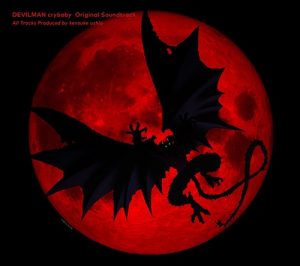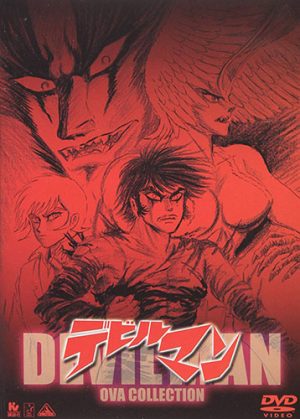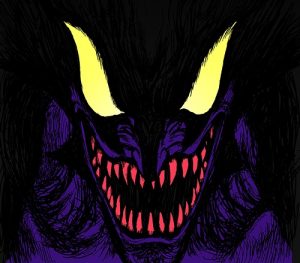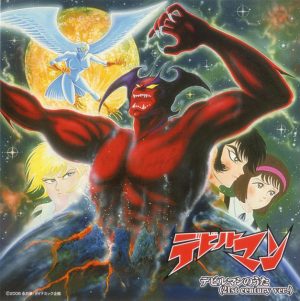
The original Devilman manga by Go Nagai was published in 1972, meaning that it’s over 45 years old at this point. And even though it didn’t get a full anime adaptation until Devilman: Crybaby in 2018, it’s had more than its fair share of sequels, spinoffs, and crossovers in the intervening years. And amazingly, most of them were written and illustrated by Nagai himself – from the 1970s all the way through to the 2010s!
Today, we’ll be looking at the most interesting and bizarre parts of the Devilman universe. You want knights? Futuristic battle armor? A time travel story where Akira and Ryo accidentally start Hitler down his path of evil? We’ve got all of that and much, much more.
Direct Sequels and Anime Adaptations

We’ll start off with what was, for many years, the most well-known version of Devilman: the 1973 tokusatsu-style anime created by Toei. Because this massively violent and sexual manga was obviously a perfect fit for a kids’ superhero show. Naturally, many of the racier parts were dropped and the narrative became a more traditional monster-of-the-week show – although it still had some surprisingly dark undertones. Amon actually kills Akira at the beginning and just wears his skin for the rest of the series. Yikes! Today, the tokusatsu Devilman is best remembered for its iconic character designs as well as its theme song, which inspired that sick as hell remix in Crybaby.
Later on in the ‘70s, Nagai decided to create a short sequel/interquel to the original story called Shin (“New”) Devilman. Akira and Ryo travel through time killing demons in eras like Joan of Arc’s France and the Wild West, but what you really need to know is that their actions unintentionally caused a young artist named Adolf Hitler to hate the Jewish people. Go Nagai, we know it’s your story and all, but what on Earth were you thinking?
Other direct adaptations include the ‘80s OVAs (the hilarious English dubs of which we’ve covered in another article), an OVA centered on Amon, and the modernized Crybaby. Akira himself has also appeared in a number of crossover specials, teaming up with the casts of other Nagai properties like Cutey Honey and Mazinger Z, as well as other classic heroes like the cyborgs from Cyborg 009. But no matter what he looks like or who he’s got on his side, Akira is always ready to save the day.
Violence Jack and Devilman Lady

Violence Jack from 1973 and Devilman Lady from 1997, both written by Nagai himself, are both spiritual successors of sorts to the Devilman manga. The plots and characters are different, but they explore similar themes and show how a person like Akira would change depending on their circumstances.
Violence Jack takes out most of the supernatural elements and focuses instead on a burly man who seems like the very personification of the devil but helps people in need when they least expect it. This manga is a lot like Mad Max, except that it came out six years earlier. It also has its own OVA with a hilarious English dub that must be seen to be believed (it contains the phrase “Now it’s your turn, Captain Buttwipe”).
Devilman Lady, on the other hand, updates the setting to 1997 and stars a strong female Devilman named Jun who uses her wits to unravel the sinister truth that her best friend is hiding from her. It’s a bit exploitative and there’s a fair amount of violence against women, but we can still recommend this manga for its clever interweaving of the original Devilman story with its own version. Jun actually meets Akira in Hell (long story) and they work together to escape! With their powers combined, they make quite a fearsome team.
Other Weird Spinoffs
In addition to high-profile anime adaptations, direct sequels, and alternate retellings that became classics in their own right, the Devilman universe also has some tertiary spinoffs. Most of them were written by Nagai in the 2000s and 2010s: Demon Knight, which retold the demons’ history as a series of medieval knight battles; Devilman Saga, which switched demon transformations with futuristic battle armor; and Sirene-chan, a short gag manga about Sirene being Akira’s classmate and laying an egg during school lunch.
But, by far, the most notable member of this group was Amon: The Darkside of Devilman. Written by Yu Kinutani in 1999, this manga explored the origins of Amon and introduced the idea (later incorporated into canon) that Akira and Ryo are stuck in a time loop that they’re forced to repeat forever. This retroactively made every other adaptation and reimagining canon, since they can all be read as different timelines of the same story.
Final Thoughts

With all of these loose adaptations, spinoffs, and spiritual successors, it’s crazy that there wasn’t a full and accurate anime version of the original manga until 2018. But if there’s one thing that this never-ending fountain of Devilman variations shows us, it’s that Nagai’s original manga has a rock solid story that can be told in countless ways without ever losing its meaning.
What did you think of our exploration into the many forms of Devilman? Have you seen or read any of these crazy spinoffs? Let us know in the comments, and thanks so much for reading!
Recommended Post
Netflix Anime DEVILMAN Crybaby Reveals Honey's Highlights!
Recommended Post
6 Anime Like DEVILMAN Crybaby [Recommendations]
Recommended Post
The Hilariously Bad 1987 Devilman OVA Dub
Recommended Post
The Far-Reaching Influence of Devilman
Recommended Post





